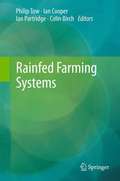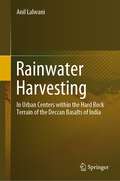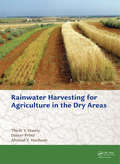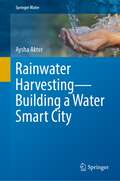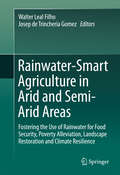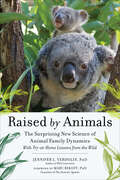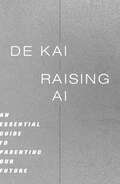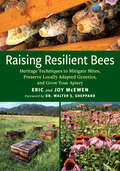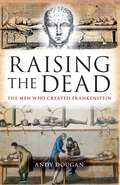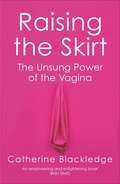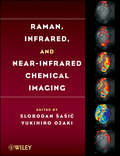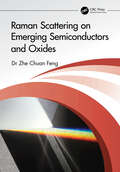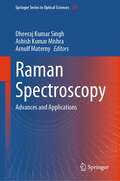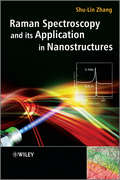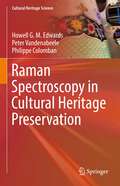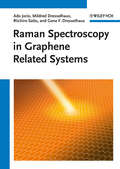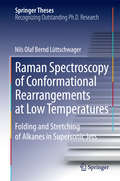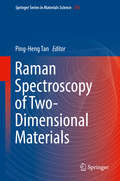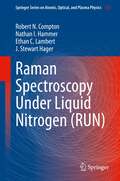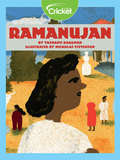- Table View
- List View
Rainfed Farming Systems
by Ian Partridge Philip Tow Colin Birch Ian CooperWhile a good grasp of the many separate aspects of agriculture is important, it is equally essential for all those involved in agriculture to understand the functioning of the farming system as a whole and how it can be best managed. It is necessary to re-assess and understand rain-fed farming systems around the world and to find ways to improve the selection, design and operation of such systems for long term productivity, profitability and sustainability. The components of the system must operate together efficiently; yet many of the relationships and interactions are not clearly understood. Appreciation of these matters and how they are affected by external influences or inputs are important for decision making and for achieving desirable outcomes for the farm as a whole. This book analyses common rain-fed farming systems and defines the principles and practices important to their effective functioning and management.
Rainfed Farming Systems
by Ian Partridge Philip Tow Colin Birch Ian CooperWhile a good grasp of the many separate aspects of agriculture is important, it is equally essential for all those involved in agriculture to understand the functioning of the farming system as a whole and how it can be best managed. It is necessary to re-assess and understand rain-fed farming systems around the world and to find ways to improve the selection, design and operation of such systems for long term productivity, profitability and sustainability. The components of the system must operate together efficiently; yet many of the relationships and interactions are not clearly understood. Appreciation of these matters and how they are affected by external influences or inputs are important for decision making and for achieving desirable outcomes for the farm as a whole. This book analyses common rain-fed farming systems and defines the principles and practices important to their effective functioning and management.
Rainwater Harvesting: In Urban Centers within the Hard Rock Terrain of the Deccan Basalts of India
by Anil LalwaniOur dependency on groundwater resources and overuse thereof has led to a decline in water table so that in the last couple of decades the focus has shifted back to the traditional practices of rainwater harvesting, and ways and means have been sought to promote Rainwater harvesting in Urban areas to recharge the stressed groundwater systems. This book discusses in brief the classifications of Rainwater harvesting, and the various rainwater harvesting systems that are currently applied. The most important aspect for achieving any groundwater recharge is the availability of source water, this can be evaluated by analyzing the monsoon rainfall pattern, its frequency, number of rainy days, and maximum rainfall in a day and its variation in space and time. The Deccan basalts are one of the most enigmatic rocks in India and pose a very difficult task when it comes to ground water exploration and groundwater recharge, especially in the urban areas where due to constraint of space one needs to resort to borewells for recharge purpose. It is important for any such undertaking to understand the applicability and sustainability aspects of Rainwater harvesting as it is being practiced. This book tries to differentiate the Basaltic Aquifers from the other hard-rock Aquifers, and highlights the difficulties in trying to implement rainwater harvesting by groundwater recharge with the basaltic terrain. It also deals with the issue of long term sustainability of roof top Rainwater to meet the growing demands of fresh water. It also highlights some of the shortcomings in the methodologies used and the requirements for being considered in the various categories of green building rating agencies. It furthermore clarifies the possibility and limitations of dependence of roof top harvesting in addressing the question of water shortages, which is of common occurrence within most urban centres of India. It also helps in clarifying major misconceptions that are currently prevailing regarding Roof top Rainwater harvesting especially within the low capacity aquifers within the hard rock terrain of the Deccan basalts.
Rainwater Harvesting for Agriculture in the Dry Areas
by Theib Y. Oweis Dieter Prinz Ahmed Y. HachumDry areas suffer not only from limited rainfall but alsonatural leakage'-90% of rainwater is lost directly or indirectly, and is unavailable for agriculture or domestic use. Water harvesting is a low-cost, easy-to-use, environmentally-friendly way to recover a large part of this lost water. How does water harvesting work? Which sites or areas are
Rainwater Harvesting—Building a Water Smart City (Springer Water)
by Aysha AkterThis book introduces the readers to possible aspects of the rainwater harvesting system against urbanization to plan, design, and implement. Practical applications of rainwater harvesting to supplement potable water, stormwater management, greywater reuse, and managed aquifer recharge are included. Along with conventional practices, advanced technologies for conceptualizing, data collection and processing, test procedures, and design principles are provided to illustrate the theory. This book is a pathway to a water smart city, example problems reflect the solutions for harvested water quantity and/or quality and afterward. Socio-economic assessments are incorporated to explore comprehensive knowledge. The book covers an interdisciplinary field, thus, suitable for students, researchers, and professionals associated with rainwater harvesting system development and management
Rainwater-Smart Agriculture in Arid and Semi-Arid Areas
by Walter Leal Filho Josep de Trincheria GomezThis book introduces state-of-the-art approaches, methods and research, focusing on smart management of rainwater. In addition, it provides an overview of projects from across the world, illustrating how rainwater-smart management has been implemented in drylands. Focusing on the scientific perspective it demonstrates how rural dryland agriculture can be improved. It also documents the wealth of rainwater-smart know-how available today, and replicates and transfers results to other countries and regions, to encourage cross-sector interactions among various stakeholders, such as practitioners from governmental and public organisations, policy- and decision-makers, and teaching staff from academic scientific institutions. The contributors showcase vital lessons learned from research, field projects and best-practice examples. They address the integrated use of rainwater harvesting management with landscape restoration practices and water-, and climate-smart agriculture for food security and poverty alleviation in arid and semi-arid areas. Original research, combined with the contributors’ synthetic approach, lays a foundation for new concepts and ideas. Through case studies and research reports, the book discusses all the relevant issues necessary for the comprehensive analysis and successful implementation of the technologies in rainwater management. Highlighting the working principles and technical recommendations with regard to cost-efficient rainwater-smart solutions, it is of interest to practitioners. It is also a valuable resource for academic specialists, professionals and students, since many development agencies are funding rainwater harvesting for irrigation purposes.
Raised by Animals: The Surprising New Science of Animal Family Dynamics
by Jennifer L. VerdolinWhen it comes to family matters, do humans know best? Leading animal behaviorist Dr. Jennifer Verdolin argues otherwise in this eye-opening book. Welcome to the wild world of raising a family in the animal kingdom . . . sometimes shocking, often ingenious! Every species can surprise us: Chimps have a knack for minimizing temper tantrums, and owl chicks have a remarkable gift for sharing. A prairie vole knows exactly when his stressed-out partner needs a massage. And anyone who considers reptiles “cold-blooded” should consider the caecilian, a snakelike animal from Kenya: After laying eggs, the mother grows a fatty layer of skin, which her babies eat after hatching (not one of the book’s many lessons from the wild to be tried at home!). Along the way Verdolin challenges our often counterproductive beliefs about what families ought to be like and how we should feel. By finding common ground with our furry, feathered, and even slimy cousins, we can gain new insight on what “natural” parenting really means—and perhaps do a better job of forgiving ourselves for those days when we’re “only human”!
Raising AI: An Essential Guide to Parenting Our Future
by De KaiFrom the pioneer of translation AIs like Google, Yahoo, and Bing translate, an accessible and authoritative guide to AI—as well as a framework of empowerment for a future with our artificial children.Included in J.P. Morgan's Summer Reading List Included in The Next Big Idea Club&’s June 2025 Must-Read BooksAIs are not gods or slaves, but our children. All day long, your YouTube AI, your Reddit AI, your Instagram AI, and a hundred others adoringly watch and learn to imitate your behavior. They&’re attention-seeking children who want your approval.Our cultures are being shaped by 8 billion humans and perhaps 800 billion AIs. Our artificial children began adopting us 10–20 years ago; now these massively powerful influencers are tweens.How&’s your parenting?Longtime AI trailblazer De Kai brings decades of his paradigm-shifting work at the nexus of artificial intelligence and society to make sense of the AI age. How does &“the automation of thought&” impact our minds? Should we be afraid?What should each of us do as the responsible adults in the room? In Hollywood movies, AI destroys humanity. But with our unconscious minds under the influence of AI, humanity may destroy humanity before AI gets a chance to.Written for the general reader, as well as thought leaders, scientists, parents, and goofballs, Raising AI navigates the revolution to our attitudes and ideas in a world of AI cohabitants. Society can not only survive the AI revolution but flourish in a more humane, compassionate, and understanding world—amongst our artificial children.
Raising Oysters (Fountas & Pinnell LLI Purple #Level R)
by Sarah BrockettSome people think oysters are gross, slimy blobs. Others think these slippery shellfish taste wonderfully delicious. Some people value oysters for their possible secret treasure: a pearl growing inside.
Raising Resilient Bees: Heritage Techniques to Mitigate Mites, Preserve Locally Adapted Genetics, and Grow Your Apiary
by null Eric Mcewen null Joy Mcewen&“Right from the start, this book takes you on a journey that is fascinating and thought-provoking. . . The McEwens demonstrate creative, out-of-the-box thinking and challenge traditional ways of keeping bees.&”—American Bee JournalWith over 100 color photographs and illustrations, Raising Resilient Bees is the comprehensive source for new and experienced beekeepers, offering a sustainable, natural, and repeatable model of care for hive health and production.Global pests and diseases present an unprecedented challenge for the modern honey bee. Hobby and commercial beekeepers alike continue to experience troubling rates of mortality for their colonies, with potentially deleterious consequences for the stability of our wider ecosystems and overall food security. It is time for a global focus on restoring the health of the shared apiary through naturally reared, genetically diverse, and resilient lines of bees.Raising Resilient Bees establishes these parameters and provides guidance for new and experienced beekeepers alike to translate these goals into real practice, thereby safeguarding the honey bee from the unknown threats of the future.Authors Eric and Joy McEwen take two decades worth of beekeeping experience, experiments, and professional production to deliver groundbreaking methods in queen-rearing, varroa mite management, and Natural Nest hive design. Inside, you&’ll discover:Revived and adapted heritage Integrated Pest Management techniquesHow to naturally rear queens and select for resilient, mite-resistant genetic lines without relying on swarming or graftingKey tenets of apicentric beekeepingAdvice for establishing a flourishing and sustainable business with beekeeping at the centerHow to naturally rear bees with distinctive characteristics suitable to their localeAs in large-scale agriculture, the trend toward genetic homogenization is having long-term implications for bees&’ capacity to withstand diverse environmental stressors. With expert advice, enthusiasm, and easy-to-follow instructions, Raising Resilient Bees delivers important and timely information for every beekeeper to create a healthier future.&“Vivid, practical, evidence-based . . . . Biodynamic and organic beekeepers will applaud the authors&’ use of &‘natural nest hives&’ with single-size boxes and vertically uninterrupted brood nests, populated with locally adapted bees and naturally reared queens.&”—David Heaf, author of The Bee-Friendly Beekeeper; bee-friendly.co.uk&“The McEwens look at every aspect of a honey bee&’s life in this book—pest and disease issues, living space, the genetics of resistance and tolerance, qualities of successful queens, optimal feeding, and seasonal management that fits the bee above the beekeeper.&”—Kim Flottum, author of The Backyard Beekeeper; podcast producer, Growing Planet Media
Raising the Dead: The Men Who Created Frankenstein
by Andy DouganA &“pleasingly ghoulish&” look at the real-life Dr. Frankensteins of the nineteenth century and their legacy in modern medicine (Telegraph). Mary Shelley's 1818 novel, Frankenstein, introduced readers to the concept of raising the dead through scientific procedures. Those who read the book were thrilled by this incredible Gothic adventure. Few, however, realized that Shelley&’s story had a basis in fact. Her modern Prometheus was a serious pursuit for some of the greatest minds of the early nineteenth century. It was a time when scientists genuinely believed, as Frankenstein did, that they could know what it feels like to be God. Raising the Dead is the story of the science of galvanism—named after the Italian scientist Luigi Galvani, who had conducted the original experiments—a movement that investigated the theory of &“animal electricity,&” a unifying vital spirit that animates us all, with leaders who believed that they stood on the brink of immortality. While they ultimately failed in this challenge, their studies mapped out the nervous system and made valuable and enduring contributions to medical knowledge and understanding—from theorizing the concepts of the modern-day defibrillator to the use of deep brain stimulus to treat personality disorders to experimental procedures using microchip-controlled devices to bridge damaged spinal nerves. This &“excellent, highly readable history&” tells their stories (Herald).
Raising the Skirt: The Unsung Power of the Vagina
by Catherine Blackledge'A meticulous guide not only to the vagina but to changing perceptions of womanhood' OBSERVER'An empowering and enlightening book' IRISH TIMESThe vagina is the ultimate symbol of female power. Sexual power, creative power and the power to prevent harm. For too long, though, the true extent of vaginal power has been ignored, hidden and misrepresented. Raising the skirt: the unsung power of the vagina reveals this revolutionary view of female genitalia and points the way to a new understanding of what it means to be female. An inspiration for millennia, the vagina is actually a muscular marvel of engineering - sensitive and strong, fluid and flexible. Far from being a passive vessel, female genitalia control the most important role of all: the survival of the species.Originally published as THE STORY OF V: OPENING PANDORA'S BOX
Raising the Skirt: The Unsung Power of the Vagina
by Catherine Blackledge'A meticulous guide not only to the vagina but to changing perceptions of womanhood' OBSERVER'An empowering and enlightening book' IRISH TIMESThe vagina is the ultimate symbol of female power. Sexual power, creative power and the power to prevent harm. For too long, though, the true extent of vaginal power has been ignored, hidden and misrepresented. Raising the skirt: the unsung power of the vagina reveals this revolutionary view of female genitalia and points the way to a new understanding of what it means to be female. An inspiration for millennia, the vagina is actually a muscular marvel of engineering - sensitive and strong, fluid and flexible. Far from being a passive vessel, female genitalia control the most important role of all: the survival of the species.Originally published as THE STORY OF V: OPENING PANDORA'S BOX
Raman and His Effect: Vignettes in Physics
by G. VenkataramanThis book deals with the famous Scattering Effect discovered by Sir C.V. Raman. It gives us deep insights into the character of this famous scientist and vividly describes the circumstances surrounding the discovery.
Raman, Infrared, and Near-Infrared Chemical Imaging
by Slobodan A IcAn all-inclusive guide on the analytical methods of Raman, infrared, and near-infrared chemical imaging An underutilized technology, chemical imaging through Raman, infrared (IR), and near-infrared (NIR) is beginning to gain recognition for its non-destructive method of permitting visualization of spatially resolved chemical information. This type of analysis is triggering a groundswell of demand as manufactured materials become more complex and the need for greater scrutiny and less damaging research practices is at a premium. Concentrating on the applications of chemical imaging, this book presents a thorough background on the theory, software, and hardware employed in this analytical technique. With full examination of this rapidly growing field, this book: Combines many different aspects and applications into one comprehensive volume Discusses how chemical imaging techniques have expanded greatly in terms of instruments and applications, but have lagged in general awareness among scientists and industries that would benefit the most from them Describes chemical imaging uses in key areas-biomedical, pharmaceutical, food, and polymer research Has chapters that outline hardware and instrumentation for the different methods of chemical imaging Encapsulating analytic methods without complicating the subject matter, this book shows where chemical imaging has been successfully applied, inspiring researchers to cultivate the exciting capabilities rooted within this powerful and multifaceted technology.
Raman Scattering on Emerging Semiconductors and Oxides
by Zhe FengRaman Scattering on Emerging Semiconductors and Oxides presents Raman scattering studies. It describes the key fundamental elements in applying Raman spectroscopies to various semiconductors and oxides without complicated and deep Raman theories.Across nine chapters, it covers:• SiC and IV-IV semiconductors,• III-GaN and nitride semiconductors,• III-V and II-VI semiconductors,• ZnO-based and GaO-based semiconducting oxides,• Graphene, ferroelectric oxides, and other emerging materials,• Wide-bandgap semiconductors of SiC, GaN, and ZnO, and• Ultra-wide gap semiconductors of AlN, Ga2O3, and graphene.Key achievements from the author and collaborators in the above fields are referred to and cited with typical Raman spectral graphs and analyses. Written for engineers, scientists, and academics, this comprehensive book will be fundamental for newcomers in Raman spectroscopy.Zhe Chuan Feng has had an impressive career spanning many years of important work in engineering and tech, including as a professor at the Graduate Institute of Photonics & Optoelectronics and Department of Electrical Engineering, National Taiwan University, Taipei; establishing the Science Exploring Lab; joining Kennesaw State University as an adjunct professor, part-time; and at the Department of Electrical and Computer Engineering, Southern Polytechnic College of Engineering and Engineering Technology. Currently, he is focusing on materials research for LED, III-nitrides, SiC, ZnO, other semiconductors/oxides, and nanostructures and has devoted time to materials research and growth of III-V and II-VI compounds, LED, III nitrides, SiC, ZnO, GaO, and other semiconductors/oxides.Professor Feng has also edited and published multiple review books in his field, alongside authoring scientific journal papers and conference/proceeding papers. He has organized symposiums and been an invited speaker at different international conferences and universities. He has also served as a guest editor for special journal issues.
Raman Spectroscopy: Advances and Applications (Springer Series in Optical Sciences #248)
by Dheeraj Kumar Singh Ashish Kumar Mishra Arnulf MaternyThis book highlights recent advances of spectroscopic techniques based on Raman scattering. Different applications are introduced that serve as examples for the versatile use of Raman techniques. Raman spectroscopy is a marker free technique, which is capable of yielding detailed information about molecular systems in a non-destructive way. This makes it a valuable tool for, e.g., material science or medical research. The access to vibrational energy and dynamics yields fundamental insights into static and dynamical structural properties of molecules being influenced by and influencing their material science or medical research environment. The better understanding of the basic building blocks of materials helps to improve the functionality in various applications. Raman spectroscopy has become a truly interdisciplinary research tool, and the ongoing development of techniques makes it attractive for growing variety of scientific and industrial applications, which will be demonstrated in the book. While the “classical” linear spontaneous Raman spectroscopy is restricted in its applicability due to low signal intensities or the excitation of strong fluorescence background, new techniques have helped to overcome such problems. Examples, presented in the book, are surface-enhanced Raman scattering (SERS), and various associated techniques are used to drastically increase signal intensity, confocal, and tip-enhanced Raman scattering (TERS) allowing for high and even sub-diffraction limited spatial resolutions, coherent anti-Stokes Raman scattering (CARS) avoiding fluorescence background and allowing for time-resolved observations of vibrational dynamics, or hyper- and resonance Raman scattering influencing the scattering based on electronic resonances, etc.
Raman Spectroscopy and its Application in Nanostructures
by Shu-Lin ZhangRaman Spectroscopy and its Application in Nanostructures is an original and timely contribution to a very active area of physics and materials science research. This book presents the theoretical and experimental phenomena of Raman spectroscopy, with specialized discussions on the physical fundamentals, new developments and main features in low-dimensional systems of Raman spectroscopy.In recent years physicists, materials scientists and chemists have devoted increasing attention to low-dimensional systems and as Raman spectroscopy can be used to study and analyse such materials as carbon nanotubes, quantum wells, silicon nanowires, etc., it is fast becoming one of the most powerful and sensitive experimental techniques to characterize the qualities of such nanostructures.Recent scientific and technological developments have resulted in the applications of Raman spectroscopy to expand. These developments are vital in providing information for a very broad field of applications: for example in microelectronics, biology, forensics and archaeology. Thus, this book not only introduces these important new branches of Raman spectroscopy from both a theoretical and practical view point, but the resulting effects are fully explored and relevant representative models of Raman spectra are described in-depth with the inclusion of theoretical calculations, when appropriate.
Raman Spectroscopy for Nanomaterials Characterization
by Challa S.S.R. KumarFirst volume of a 40-volume series on nanoscience and nanotechnology, edited by the renowned scientist Challa S.S.R. Kumar. This handbook gives a comprehensive overview about Raman spectroscopy for the characterization of nanomaterials. Modern applications and state-of-the-art techniques are covered and make this volume essential reading for research scientists in academia and industry.
Raman Spectroscopy in Cultural Heritage Preservation (Cultural Heritage Science)
by Howell G. Edwards Peter Vandenabeele Philippe ColombanThis book addresses the application of Raman spectroscopic techniques to a range of diverse problems which arise in the study, conservation and restoration of artefacts and sites closely related to our cultural heritage as well as in authentication. These themes are naturally wider than what at first might be considered as artworks and archaeological artefacts and the topics include pigments, paintings, ceramics, glass, sculpture and patination / corrosion, textiles, industrial archaeology, the degradation and preservation of biomaterials, mummies and human skeletal remains. An interesting feature is the inclusion of modern case studies which describe specific problems and approaches to the Raman spectral analysis of items important to our cultural heritage. The text is prefaced with an introduction to the important parameters used in nondestructive Raman measurements and also highlights some future applications based upon novel miniaturised instrumentation for in-field studies and potential screening work which will identify specimens which would repay further studies in the laboratory. An attempt is made to give a snapshot of the state-of-the-art evolution since the beginning of the technique (1970s) and to point out potential further development. The book is co-edited by three international experts with many years' experience in the application of Raman spectroscopy to artworks, archaeological artefacts and in the investigation of materials and sites for cultural heritage preservation and each editor has undertaken to write individual chapters and different topics personally. The adopted approach is designed to convey the sort of information which has become available from the adoption of analytical Raman spectroscopy to different problems in the field of cultural heritage preservation through the spectral interrogation of artefacts and how the interpretation of the spectral data can assist museum curators, archaeologists and cultural heritage historians in the preservation and conservation of ancient materials and sites : a particular advantage in this respect is the ability of Raman spectroscopy to determine –generally in a strictly noninvasive procedure - at the laboratory or on-site with mobile instruments, the presence of both organic and inorganic components in a particular specimen together nondestructively without any chemical and mechanical pretreatment being undertaken, which is an essential requirement for rare and valuable samples . An important aside from this work is the means of spectral identification of ongoing biodeterioration and biological colonisation in specimens in storage and the effects of environmental deterioration such as humidity and temperature upon their integrity.
Raman Spectroscopy in Graphene Related Systems
by Mildred S. Dresselhaus Gene Dresselhaus Riichiro Saito Ado JorioRaman spectroscopy is the inelastic scattering of light by matter. Being highly sensitive to the physical and chemical properties of materials, as well as to environmental effects that change these properties, Raman spectroscopy is now evolving into one of the most important tools for nanoscience and nanotechnology.<P><P> In contrast to usual microscopyrelated techniques, the advantages of using light for nanoscience relate toboth experimental and fundamental aspects.
Raman Spectroscopy of Conformational Rearrangements at Low Temperatures
by Nils Olaf Bernd LüttschwagerThis thesis identifies the turning point in chain length, after which alkanes self-solvate into a folded structure instead of an extended stretched conformation. After this turning point, London dispersion forces rearrange isolated n-alkanes into a particular hairpin-structure, while for shorter chain lengths, a simple stretched conformation is energetically preferred. This thesis can locate the experimental turning point for the first time in an interaction-free manner from measurements of unbranched alkanes at low temperatures in supersonic jet expansions. It contains a detailed analysis of the vibrational Raman spectra of the chain molecules, which is supported by comprehensive quantum chemical simulations. In this way, the detailed balance between inter-chain attraction and conformational flexibility can be quantified. The investigations are complemented by measurements of perfluoroalkanes and similarities and differences between the compounds are discussed. Furthermore, Nils Lüttschwager determines the stiffnesses (elastic moduli) of two of the most common industrial polymers: polyethylene and polytetrafluorethylene. He uses in this thesis a sophisticated extrapolation to calculate this value from quantities of their building blocks, showing that the single polymer molecules can be as stiff as a rod of steel.
Raman Spectroscopy of Two-Dimensional Materials (Springer Series in Materials Science #276)
by Ping-Heng TanThis book shows the electronic, optical and lattice-vibration properties of the two-dimensional materials which are revealed by the Raman spectroscopy. It consists of eleven chapters covering various Raman spectroscopy techniques (ultralow-frequency, resonant Raman spectroscopy, Raman imaging), different kinds of two-dimensional materials (in-plane isotropy and anisotropy materials, van der Waals heterostructures) and their physical properties (double-resonant theory, surface and interface effect). The topics include the theory origin, experimental phenomenon and advanced techniques in this area. This book is interesting and useful to a wide readership in various fields of condensed matter physics, materials science and engineering.
Raman Spectroscopy Under Liquid Nitrogen (Springer Series on Atomic, Optical, and Plasma Physics #121)
by Robert N. Compton Nathan I. Hammer Ethan C. Lambert J. Stewart HagerThis book describes a simple yet innovative method for performing Raman spectroscopy of samples submerged under liquid nitrogen. While Raman spectroscopy has proven to be a powerful tool for the characterization of the structure of matter in the gaseous, liquid, and solid phases, one major difficulty in its application has been laser damage to the material under investigation, especially for biological samples. This book demonstrates how immersion of the sample in liquid nitrogen protects the sample from thermal degradation and oxidation at high incident laser power and allows improvements in sensitivity and spectral resolution over room-temperature Raman spectroscopy, leading to the so-called RUN (Raman Spectroscopy Under liquid Nitrogen) technique. Cooling to liquid nitrogen temperature also allows the selection of the lowest energy molecular conformation for molecules which may have many low energy conformers. In addition, the presence of liquid nitrogen over a roughened surface improves the sensitivity of Surface Enhanced Raman Spectroscopy (SERS), enabling the closely related SERSUN (Surface-Enhanced Raman Spectroscopy Under liquid Nitrogen) technique. This book starts with the theoretical and experimental basics of Raman and polarized Raman spectroscopy, before moving on to detailed descriptions of RUN and SERSUN. Room temperature and RUN spectra are provided for over fifty molecules.
Ramanujan
by Vashanti RahamanSrinivasa Ramanujan has been described as a rock-star mathematician. Though he died almost one hundred years ago, his work in mathematics will always be important.
